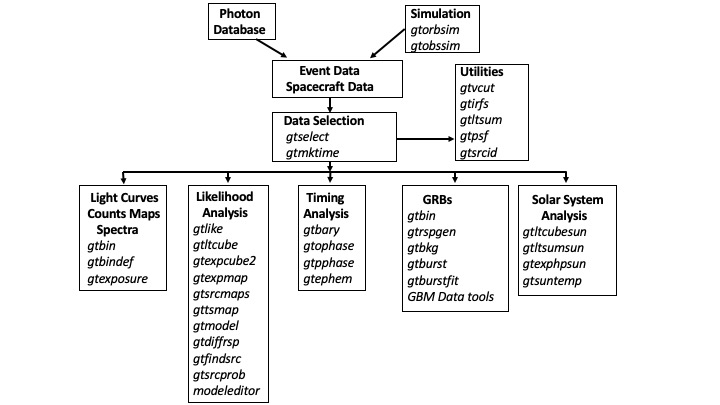Overview & Reference Guide
The Fermi mission provides a suite of tools called the Fermitools for the analysis of LAT data, which were created by the FSSC and the LAT instrument team. The FSSC handles the distribution and ongoing maintenance of this software package. The tools use the HEADAS FTOOLS framework, a design choice that promotes compatibility across different missions and reduces the learning burden for researchers already familiar with other high-energy astrophysics datasets. See documentation for how to do Fermi analysis. The accompanying graphic demonstrates the typical analysis workflow using these tools.

The following set of Fermi-specific tools are used to analyze LAT data, but, some tools, such as gtbin, can also process GBM data products.
-
Tool Description gtselect Performs selection cuts on event data files. gtbin Bins GBM or LAT event lists in time, energy, and/or space to produce light-curves, spectra, count cubes or count maps, respectively. gtbkg Creates a background spectrum file (PHA1 format). gtexpcube2 Generates an exposure map, or a set of exposure maps for different energies, from a livetime cube written by gtltcube. gtexposure Given a counts light curve prepared using gtbin for a specific location on the sky, this tool computes the exposure (cm2-s) associated with each time bin, allowing for a light curve in photons/s to be computed. gtirfs Give the list of possible irfs gtltcube Calculates integrated livetime as a function of sky position and off-axis angle. gtltsum Adds together livetime cubes produced by gtltcube. gtmktime Create Good Time Intervals (GTIs) based on selections made using the spacecraft data file variables. gtpsf Calculates the effective point spread function, as a function of energy at a given source location, averaged over an observation. gtvcut This tool displays a summary of the Data Sub-Space keywords. -
Tool Description gtdiffrsp Calculates the integral over solid angle of a diffuse source model convolved with the instrumental response function. gtexpmap Calculates exposure maps for unbinned likelihood analysis. gtfindsrc Optimizes a point source location using the likelihood test-statistic. gtlike Performs unbinned or binned likelihood analysis of LAT data. gtltcube Calculates integrated livetime as a function of sky position and off-axis angle. gtmodel Creates a model counts map based on a binned likelihood fit. gtsrcmaps Convolves source model components with instrument response. gtsrcprob Computes source component probabilities for event data. gttsmap Calculates test-statistic map for source localization and detection. modeleditor Create model files for use as input to the Fermi likelihood estimation program. -
Tool Description gtsrcid Creates a counterpart candidate catalog by correlating the objects from a list of detected sources with the objects of an existing source catalog, such as the 3EG catalog. -
Tool Description gtbin Bins GBM or LAT event lists in time, energy, and/or space to produce light curves, spectra, count cubes, or count maps. gtbindef Generates an energy or time bin definition FITS file to be used with gtbin.gtrspgen Creates a Detector Response Matrix (DRM or RSP) FITS file from multi-dimensional response functions. gtburstfit Analyzes burst light curves by applying a Bayesian algorithm to determine the optimum set of blocks to follow the burst profile shape, then optionally fitting a model to the data using the Bayesian Block definitions to determine the number of model components and initial values for the model parameters. -
Tool Description gtbary Performs barycentric or geocentric corrections to photon arrival times. gtophase Computes an orbital phase for each event in input event file(s), and writes it to a FITS column in the file(s). gtpphase Computes a pulse phase for each event in input event file(s), and writes it to a FITS column in the file(s). -
Tool Description gtltcubesun Calculates integrated livetime as a function of sky position, instrument angle, and distance from a solar system body (Sun or Moon). gtltsumsun Adds together livetime cubes produced by gtltcubesun.gtexphpsun Calculates the exposure for different energies as a function of distance from the Sun or Moon using the livetime cube generated by gtltcubesun. Used bygtsuntempto compute exposure-weighted intensity.gtsuntemp Generates average intensity skymaps as a function of energy for the Sun or Moon. The output FITS file can be used in likelihood analysis similar to diffuse emission models. -
Tool Description gtobssim Generate photon events from astrophysical sources and process those photons according to the specified instrument response functions. gtorbsim Generate spacecraft orbit and attitude data for a variety of pointing or survey mode strategies. modeleditor Create model files for use as input to the Fermi likelihood estimation program.
